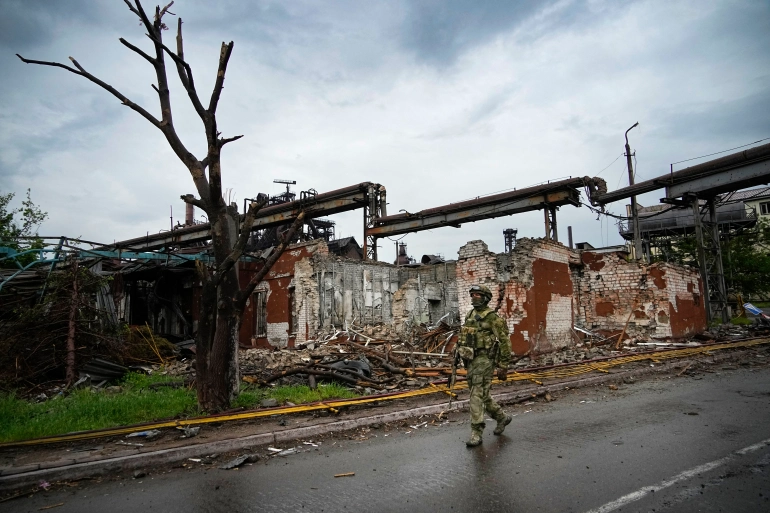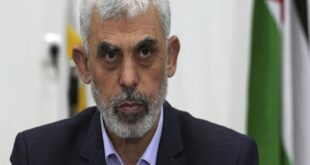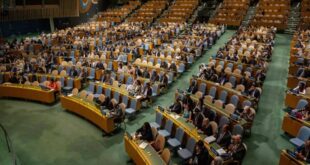
Despite many setbacks and disappointments, Russia appears to be making significant progress with regards to the officially declared goals of its war on Ukraine.
The last of the Ukrainian defenders in the port city of Mariupol surrendered at the Azovstal plant on Friday. The fact that at least half of them belong to the Azov regiment, created by far-right militants in 2014, offers the Kremlin a chance to claim major progress with regards to one of the officially declared goals of its war on Ukraine – the “denazification” of the country.
Inevitably, the Russian propaganda machine is now excitedly parading all the tattoos and patches on the uniforms of the surrendering Ukrainian soldiers, which betray the far-right sympathies of their bearers. In violation of the Geneva Convention relative to the Treatment of Prisoners of War, pro-Kremlin outlets are circulating videos of POWs, who are being forced to strip and expose their tattoos for the cameras of propagandist TV channels. Filming POWs, including scenes of their interrogation and torture, is practised by both sides in this war.
Officials in both Russia and Russian-backed unrecognised statelets in eastern Ukraine are now calling for a trial of Azov fighters. Right at the end of the Azovstal siege, the Russian Prosecutor-General’s Office appealed to the Supreme Court to declare the Azov regiment a terrorist organisation. This would potentially allow Russia to try the members of Azov in its territory as terrorists. Alternatively, the Kremlin could stage that trial in the Donetsk and Luhansk statelets, which – unlike Russia itself – practise capital punishment.
The Russian effort to highlight Ukraine’s troubling tolerance of the far right would be more convincing if Russia itself weren’t coopting them as well. The infamous Wagner Group, a private army that now fights on the Donbas front near the town of Popasna, for example, includes the Rusich unit, which is made up of open neo-Nazis from St Petersburg.
But such facts are virtually unknown to the Russian public, so with the help of its massive propaganda machine, the Kremlin will be able to tick off the goal of “denazification” as achieved, given that Azov is by far the most symbolic example of Ukraine’s controversial relationship with the far right.
But what about the other goals?
While many in the West seem to think that Putin aims to occupy the whole of Ukraine, Russia’s territorial expansion goals officially declared at the start of the operation are not nearly as ambitious. They boil down to establishing control over the entire territories of Donetsk and Luhansk in eastern Ukraine, which Russian-backed separatists have only partially controlled since 2014.
This is a rather daunting task in military terms because it involves taking over the best-fortified areas of Ukraine, which have been carefully preparing for this battle for seven years.
The Russian progress in Donbas has been steady so far, but very slow. The Russians are now close to establishing full control of Luhansk region, but Ukraine’s strongholds in Donetsk region will be a much harder nut to crack.
In terms of selling the war to the jingoist part of Russian society, any Ukrainian territory outside of Donetsk and Luhansk claimed by Russia is just a bonus. The Kremlin does not need to obtain any territory outside Donbas to convince its support base that it achieved its goals and declared victory.
The fall of Mariupol to the Russian military represents one of these bonus achievements. Russia now has a land corridor to Crimea, which it occupied in 2014. On top of that, it has ended Crimea’s water and power blockade, maintained by Ukraine all those years. The freshwater canal connecting the Dnieper River to the arid Crimean Peninsula is now in Russia’s hands. So is a nuclear power station to the north of the peninsula, not to mention the power grid in southeastern Ukraine which can be now connected to Russia.
Only historians looking into the Kremlin archives, years or decades from now, will be able to reveal the details of Putin’s original plan for Ukraine.
For now, all we know is that the first stage of the war included an ill-fated march on Kyiv and a failed attempt to encircle Ukraine’s second-largest city, Kharkiv. Was it a part of the plan for a broad occupation or a way of distracting Ukrainian forces while Russia was establishing the land corridor to Crimea?
It may well be an example of what British political scientist Mark Galeotti once dubbed the Kremlin’s “adhocracy”. Perhaps there was not much of a plan – just a desire to punish Ukraine for refusing to implement the Minsk agreements, which ended the first war in Donbas in 2014-15 and envisaged autonomy for the Russian-backed parts of Donetsk and Luhansk regions within Ukraine. A week before Putin launched his invasion of Ukraine, President Zelenskyy had called the Minsk agreements “vapid” and designed to turn Ukraine into a losing side.
In that respect, the attack on Kyiv could have been more of a punitive raid than an attempt to seize territory. The atrocities exposed after the Russian army retreated from northern Ukraine suggest that they were not exactly fighting for hearts and minds in this part of the country.
If this is indeed accurate, what’s crucial for the Kremlin is that at the end of the current war, Ukraine is forced to agree to a truce that will be much more humiliating than what was envisaged by the Minsk agreements. If the war ends with Russia occupying all of Luhansk and Donetsk plus retaining control of the land corridor to Crimea, it will be more than enough for Putin to declare a spotless victory.
But to cement his victory, the Russian leader will need to convince Ukraine to agree to a truce under such conditions, and that’s a totally different story. Ukraine and its Western allies are hoping that under pressure from crippling sanctions Russia will eventually exhaust its military and economic potential and lose the battle.
This would be a desirable outcome, not only for Ukraine and Europe but Russia itself, as it would be beneficial for the country to leave this dark period in its history behind as quickly as possible and transform into something akin to post-1945 Germany rather than continue acting as an aggressive military dictatorship and further damage its economy.
But while Russia is expected to lose 11.2 percent of its GDP this year, Ukraine’s economy may shrink by 45 percent by the end of 2022, according to the World Bank. Ukrainian officials are bragging about a major counter-offensive later this year, fuelled by all the heavy weaponry Western allies have begun supplying in recent weeks. But it’s unclear if it has the human resources to mount it. Offensives lead to considerably higher human losses than defensive wars and even with all the state-of-the-art Western weaponry, Ukraine will still be facing a very formidable enemy. The odds are high that it will reach its pain barrier long before Putin’s Russia.

By Leonid Ragozin is a freelance journalist based in Riga + Aljazeera




 World Opinions Débats De Société, Questions, Opinions et Tribunes.. La Voix Des Sans-Voix | Alternative Média
World Opinions Débats De Société, Questions, Opinions et Tribunes.. La Voix Des Sans-Voix | Alternative Média




